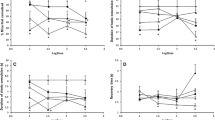Abstract
Unlike the dihydropyridine calcium channel antagonists studied previously, the benzothiazepine calcium channel antagonist, diltiazem, increased the incidence of convulsions caused by bicuculline,N-methyl-DL-aspartate or 4-aminopyridine. However, the latencies to convulsions were also increased. Diltiazem increased the ratings of convulsive behaviour on handling after intraperitoneal administration of bicuculline, or pentyl-enetetrazol and after the calcium channel activator, Bay K 8644, administered ICV. When the binding of the dihydropyridine, [3H]-nitrendipine in the CNS was measured in vivo, this was increased by diltiazem. This compound therefore showed a different pattern of interaction with convulsant drugs then that previously demonstrated for other calcium channel antagonists, appearing to possess both pro- and anticonvulsant actions, and a different pattern of interaction with the dihydropyridine receptor complex.
Similar content being viewed by others
References
Akaike N (1991) T type calcium channels in mammalian CNS neurones. Comp Biochem Physiol [C] 98:31–40
Akaike N, Kostyuk PG, Osipchuk YV (1989) Dihydropyridine sensitive low-threshold calcium channels in isolated rat hypothalamic neurones. J Physiol 412:181–195
Bianchi M, Rovati LC, Sacerdote P, Mantegazza P, Panerai AE (1990) Effect of drugs belonging to different classes of calcium channel blockers on experimental seizures induced by the calcium channel agonist Bay K 8644. Neurosci Res Commun 6:157–162
Boles RG, Yamamura HI, Schoemaker H, Roeske WR (1984) Temperature-dependant modulation of [3H]-nitrendipine binding by the calcium channel antagonists verapamil diltiazem in rat brain synaptosomes. J Pharmacol Exp Ther 229:333–339
Carboni E, Wojcik WJ (1988) Dihydropyridine binding sites regulate calcium influx through specific voltage-sensitive calcium channels in cerebellar granule cells. J Neurochem 50:1279–1286
Crabbe JC, Feller DJ, Terdal ES, Merril CD (1990) Genetic components of ethanol responses. Alcohol 7:245–248
Czuczwar SJ, Malek U, Kleinrok Z (1990) Influence of calcium channel inhibitors upon the anticonvulsant efficacy of common antiepileptics against pentylenetetrazol-induced convulsions in mice. Neuropharmacology 29:943–948
De Sarro GB, Meldrum BS, Nistico G (1988) Anticonvulsant effects of some calcium entry blockers in DBA/2 mice. Br J Pharmacol 93:247–256
Derlet RW, Albertson TE (1989) Potentiation of cocaine toxicity with calcium channel blockers. Am J Emerg Med 7:464–468
Ferry DR, Goll A, Gadow C, Glossmann H (1984) (−)3H-desmethoxyverapamil labelling of putative calcium channels in brain: autoradiographic distribution and allosteric coupling to 14-dihydropyridine diltiazem binding sites. Naunyn-Schmiedeberg's Arch Pharmacol 327:183–187
Gandolfo G, Gottesmann C, Bidard JN, Luzdunski M (1989) Ca2+ entry blockers prevent seizures induced by a class of K+ channel inhibitors. Eur J Pharmacol 160:173–177
Goldstein DB, Pal W (1971) Alcohol dependence produced in mice by inhalation of ethanol: grading the withdrawal reaction. Science 172:288–290
Green AR, Davies EM, Whittington MA, Little HJ, Cross AJ (1990) Action of chlormethiazole in a model of ethanol withdrawal. Psychopharmacology 102:239–242
Higashi H, Sugita S, Matsunari S, Nishi S (1990) Calcium-dependent potentials with different sensitivities to calcium agonists antagonists in guinea-pig hippocampal neurones. Neuroscience 34:35–47
Jamaluddin M, Thomas A (1992) Platelet activating factor-induced aggregation of calf platelets: apparent positive cooperativity in the kinetics non competitive inhibition by diltiazem. J Biosci 17:141–149
Kornecki E, Ehrlich YH, Lenox RH (1984) Platelet-activating factor-induced aggregation of human platelet specifically inhibited by triazolobenzodiazepines. Science 226:1454–1456
Laorden ML, Carrillo E, Miralles FS, Puig MM (1990) Effects of diltiazem on hyperthermia-induced seizures in the rat pup. Gen Pharmacol 21:313–315
Larkin J, Butler E, Brodie MJ (1988) Nifedipine for epilepsy? A pilot study. BMJ 296:530–531
Littleton JM, Little HJ, Whittington MA (1990) Effects of dihydropyridine calcium channel antagonists in ethanol withdrawal; doses required, stereospecificity and actions of BAY K 8644 Psychopharmacology 100:387–392
Meddis R (1984) Statistics using ranks. A unified approach. Blackwell, Oxford, New York
Meyer FB, Anderson RE, Sundt TM, Yaksh TL, Sharbrough FW (1987) Epilepsia 281:409–414
Miller RJ (1988) Calcium signalling in neurons. Trends Neurosci 11:F415–419
Nutt DJ, Cowen PJ, Green AR (1980) On the measurement in rats of the convulsant effect of drugs the changes which follow electroconvulsive shock. Neuropharmacology 19:1017–1023
Petersen EN (1986) Bay K 8644 induces a reversible spasticity-like syndrome in rats. Eur J Pharmacol 130:323–326
Rossier JR, Cox JA, Niessor EJ, Bertzen CL (1989) A new class of calcium entry blocker defined by 1,3-diphosphonates. J Biol Chem 264:16598–16607
Shelton RC, Grebb JA, Freed W (1987) Induction of seizures by intracerebroventricular administration of the calcium channel agonist Bay K 8644. Brain Res 402:399–402
Schoemaker H, Langer SZ (1985) [3H]-Diltiazem binding to calcium channels antagonist recognition sites in rat cerebral cortex. Eur J Pharmacol 111:273–277
Schoemaker H, Langer SZ (1989) Effects of Ca2+ on [3H]-diltiazem binding and its allosteric interaction with dihydropyridine calcium channel binding sites in the rat cortex. J Pharmacol Exp Ther 248:710–715
Schoemaker H, Hicks PE, Langer SZ (1987) Calcium channel receptor binding studies for diltiazem and its major metabolites: functional correlation to inhibition of portal vein myogenic activity. J Cardiovasc Pharmacol 9:173–180
Supavilai P, Karobath M (1984) The interaction of [3H]-PY 108-068 and of [3H]-PN 200-110 with calcium channel binding sites in rat brain. J Neural Transm 60:149–167
Takahashi K, Akaike N (1990) Nicergoline inhibits T-type Ca2+ channels in rat isolated hippocampal CA1 pyramidal neurones. Br J Pharmacol 100:705–710
Wauquier A, Ashton D, Clincke G, Fransen J (1985) Calcium channel entry blockers as cerebral protecting agents: comparative activity in tests of hypoxia hyperexcitability. Jpn J Pharmacol 38:1–7
Yamamura HI, Shoemaker H, Boles RG, Roeske WR (1982) Diltiazem enhancement of [3H]-nitrendipine binding to calcium channel associated drug receptor sites in rat brain synaptosomes. Biochem Biophys Res Commun 108:640–646
Author information
Authors and Affiliations
Rights and permissions
About this article
Cite this article
Watson, W.P., Little, H.J. Effects of diltiazem in convulsive states differ from those previously reported for dihydropyridine calcium channel antagonists. Psychopharmacology 114, 321–328 (1994). https://doi.org/10.1007/BF02244855
Received:
Accepted:
Issue Date:
DOI: https://doi.org/10.1007/BF02244855



